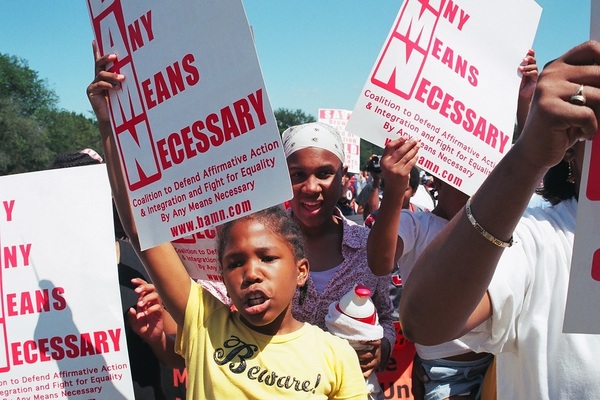
–>
November 15, 2022
If a hostile foreign power wanted to sow division in the U.S., it would be hard to think of a better tactic than promoting racial preferences. Just demand that government “level the playing field” with quotas and set-asides based on skin color, and then watch the debilitating acrimony.
‘); googletag.cmd.push(function () { googletag.display(‘div-gpt-ad-1609268089992-0’); }); }
Admitting students to college based on their race is more than just an unpopular social engineering scheme, though they are certainly that. When enacted, it is a perfectly designed mechanism to maximize group antagonisms and undermine educational excellence, and with the added advantage of disguising this harm with lofty rhetoric.
We’ll start with admissions and then examine what occurs on campuses when students arrive.
Preferences in College Admission
‘); googletag.cmd.push(function () { googletag.display(‘div-gpt-ad-1609270365559-0’); }); }
For simplicity’s sake, assume three groups of five applicants each — Whites, Asians, and Blacks — with unequal SAT scores, applying to an elite school. Here are the hypothetical SAT scores though they are consistent with actual SAT scores and admissions to elite schools:
White Asian Black
1500 1600 1300
1400 1500 1200
1300 1400 1100
1200 1300 1000
1100 1200 900
Since all students are applying to an elite school, only top scorers will be admitted. In this illustration, the top three Whites and top four Asians are admitted together with the one Black scoring 1300 for a class of eight students. But if an extra Black were admitted to achieve diversity (the applicant scoring 1200 on the SAT), at least one White or one Asian must be rejected to make room for the Black admittee. Yet, at least in this example, how many Whites might perceive themselves to have lost out due to racial preferences? The answer is three — two Whites and one Asian, all of whom scored better than or equal to the affirmative action Black admittee. In other words, enrolling Blacks who are outscored by rejected Whites and Asians exaggerates perceived racial discrimination.
Compounding this perception of discrimination among Asians is that their SAT scores now have risen and while the same is true for Blacks, raw score gaps has widened. The upshot, at least in the minds of many Asians, is the reverse of the American dream: work hard, boost test scores, and suffer even more discrimination or, conversely, for African Americans: achieving the top rungs makes little difference since elite schools will accept mediocre scores to make the “diversity numbers.” If the game is rigged, why make the extra effort?
Though it may be impossible to quantify this perceived vs. real discrimination, it must be enormous since the multiplication of feelings of injustice undoubtedly occur at hundreds of respectable colleges and universities. In fact, Harvard has rejected 1,100 student applicants with perfect 800 SAT math scores while Yale turned away several applicants with perfect 2400 scores on the three-part SAT exam (the average math SAT for Blacks in 2021 was 457). For an Asian to be admitted to Harvard, he or she must outscore the average Black admitted by 250 total points on both exams, These preferences have, moreover, existed for half a century, so generations of White and Asian Americans likely believe themselves to be victims of unfair racial preferences.
Preferences on Campus
The legal basis of affirmative action in college admissions is complicated, but beginning with the Bakke case (1978) the legal consensus seems to be that racial preferences are permitted but fixed quotas are illegal. Diversity is acknowledged as a compelling state interest insofar  as it enhances the educational experience of all students but, in some ill-defined way, there must be a light thumb on the scale when weighing race in admission. Critically, how much is “too much” has never been legally defined.
as it enhances the educational experience of all students but, in some ill-defined way, there must be a light thumb on the scale when weighing race in admission. Critically, how much is “too much” has never been legally defined.
‘); googletag.cmd.push(function () { googletag.display(‘div-gpt-ad-1609268078422-0’); }); } if (publir_show_ads) { document.write(“
Thanks to this vagueness. schools enjoy ample latitude in awarding racial preferences. Nor is the remedy clear if Blacks admitted with sub-par records perform poorly academically. Do schools flunk them out or try harder to retain them?
Into this murky situation, many schools have embraced a “critical mass” of Black students to ameliorate the problems experienced by the handful of affirmative action admissions. It is also a policy endorsed by the Supreme Court in 2003. According to this theory, if a small number of Blacks experience difficulties, admitting more Blacks will help once isolated strugglers thanks to greater interpersonal support and school-supplied tutoring and psychological counseling. This may also include Black-only dorms, Black-themed student organizations, Black-only graduation ceremonies and most of all, courses and majors largely targeting Blacks.
Unfortunately, the pernicious logic that drives the admission process likewise applies to this “critical mass” policy. In a nutshell, as the admission process digs deeper and deeper into the pool of Black applicants, the average Black admitted will be less qualified academically. Equally important, absent expanding the freshman class, the academic records of non-Black admittees will improve. It hardly exaggerates to suggest that such a campus of wide academic disparities might resemble a 19th-century European colony — a small group of talented Whites (and Asians) living amidst less capable people of color.
Meanwhile, Blacks are way in over their heads academically and thus must daily compete with academically superior Whites and Asians. That many of these struggling Black students may have been top students elsewhere prior to arriving at an elite school invites constant humiliation. Not easy for the ego always being in the bottom half of the class or having to regularly seek help from tutors.
Moreover, this unequal academic performance cannot be hidden. It will be apparent in classrooms, social events, and clubs, and the proliferation of campus “learning centers” largely catering to Blacks. Under these troubling circumstances, it is not easy to convince anybody that theories of racial superiority are just pseudo-science. Recall Groucho Marx’s quip: who are you going to believe, me or your lying eyes?
How can this unpleasant reality be managed? The answer is: denial, together with relentless propaganda about the evils of White supremacy and that social engineering performs as promised, diversity is our strength, and the disconcerting plain-to-see realities are dangerous stereotypes. It is all-hands-on-deck indoctrination, from the students shouting down Charles Murray to administrators demanding all professors celebrate Diversity, Equity and Inclusion. Woe to unbelievers who ask about the absence of Blacks in advanced STEM classes or the over-representation of Asians in mathematics. Recall the Soviet Union when its people were told to ignore shortages and shoddy merchandise, and those who did notice were shipped to the Gulag or put into therapy to cure their hallucinations. On today’s campuses, the act of noticing becomes “implicit bias” and thus a crime against official dogma.
If all these racial preference schemes were the work of a nefarious foreign government, the agents who accomplished this mission would receive medals and bonuses. Letters of commendation would proclaim how these heroes enfeebled America’s top universities by decimating the number of super-bright students admitted, how the freedom necessary to advance knowledge has been replaced by Political Correctness and how millions once spent on cutting-edge scientific research now go to bureaucratic schemes that only exacerbate tribal conflicts. Or how the need to deny the plain-to-see pernicious impact of these preferences helps push mendacious functionaries up the career ladder. All and all, a remarkable display of the damage that can be accomplished under the guise of “doing good.” How will the cases currently being considered by the Supreme Court address these issues? That remains to be seen.
Image: Elvert Barnes
<!– if(page_width_onload <= 479) { document.write("
“); googletag.cmd.push(function() { googletag.display(‘div-gpt-ad-1345489840937-4’); }); } –> If you experience technical problems, please write to [email protected]
FOLLOW US ON
<!–
–>
<!– _qoptions={ qacct:”p-9bKF-NgTuSFM6″ }; ![]() –> <!—-> <!– var addthis_share = { email_template: “new_template” } –>
–> <!—-> <!– var addthis_share = { email_template: “new_template” } –>






